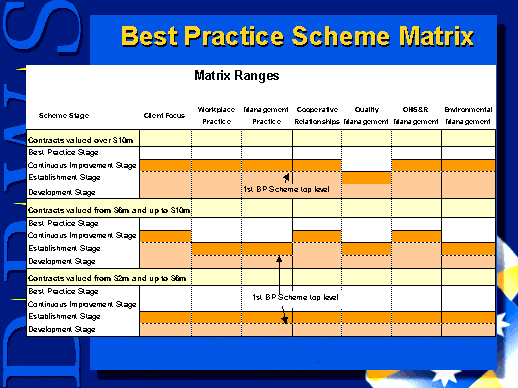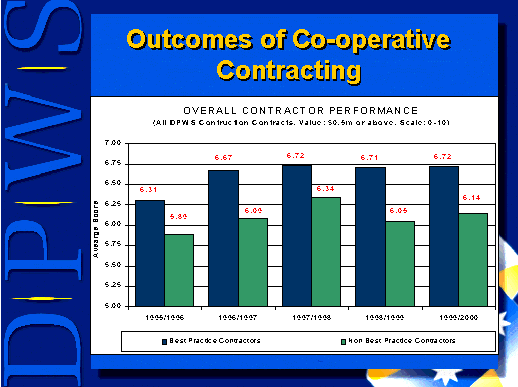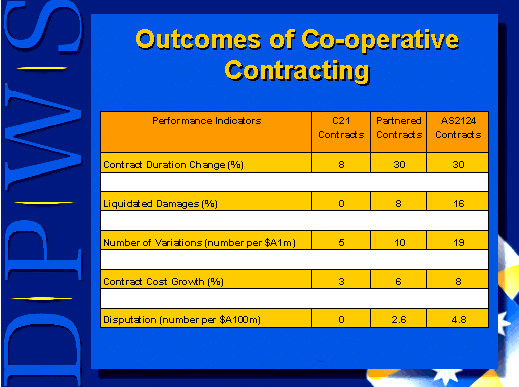|
Background
As the State's largest client, in 1992 the State Government of NSW
instigated a Royal Commission into the New South Wales Construction
Industry, to address problems in a clearly under performing
industry.
Flowing out of the Royal Commission recommendations, the Government
introduced major reforms, including the issue of Codes of Practice and
Tendering for the Construction Industry, to address corrupt and illegal
practices, to encourage better performers and to change the ethos of the
industry from adversarial, distrusting, dog-eat-dog to one of one of
co-operation and forward looking.
Code of Practice
The Code of Practice underpinned the Government's reform agenda, and it
was seen as a catalyst to turn around the prevailing destructive industry
culture. The Government used its buying power, as the largest purchaser of
capital works in the State of NSW to drive the industry into being a more
efficient, responsive and responsible partner. Failure to comply with the
Code meant no work opportunities on Government funded projects.
In a nutshell, the Code of Practice established minimum standards of
industry behavior on Government contracts. Objectives of the Code were to
improve industry efficiency and productivity; and drive workplace reform
through Best Practice in areas of:
- Industrial Relations
- Occupational Health and Safety
- Environmental Management
- Training and Skills
Formation
|
Partnering
As part of the reform process, partnering was also progressively
introduced to NSW Government projects from February 1993, with a primary
objective to reduce adversarial behaviour.
Partnering on DPWS construction contracts in the early stages was only
implemented once a contract was awarded and only if the parties agreed to
partner.
A partnering workshop was arranged, once partnering was agreed to by all
the participating stakeholders and adopted at all levels of their
respective organisations. Stakeholders can include clients, major
subcontractors, suppliers, the contractor, and DPWS.
At the partnering workshop the project participants agree upon mutual
goals for the project; develop formal problem solving and dispute
avoidance strategies: and ways to improve communication. A charter
outlining these mutual goals is prepared. The Charter however is not part
of the contract, and acts somewhat as an agreement to agree".
The Partnering process is then implemented and monitored through regular
meetings and a close-out workshop.
Key thing to remember is that this early form of partnering was an add on,
and had a limited impact due to its project by project application.
Three pillars of Co-operative Contracting
To convert the initial partnering model into a strategic model, the
concept of co-operative contracting was developed.
Co-operative Contracting consists of three major pillars; Best Practice
Contractors, the C21 Construction Contract and a comprehensive Contractor
Performance Reporting System.
These pillars are set on a foundation of the Government's Code of
Practice. This arrangement was designed to create a stronger bond of
mutual dependency between Contractors and the Department, which would act
as a positive behavior modifier i.e. a driver of cultural change.
This arrangement was seen as one often used by the Private Sector in its
forging of strategic alliances through mutual dependence.
Best Practice Contractor Scheme
DPWS, for many years has had a contractor prequalification scheme for
major building and civil works. However, many of these contractors had
shortcomings in not consistently meeting the reasonable expectations of
the Department. These shortcomings included substandard work, late
completion, excessive disputation and uncooperative behaviour.
A new strategy was needed to improve the standard of performance of
prequalified contractors.
Best Practice Strategy
The strategy chosen was that if contractors can demonstrate their head
office and site management systems were highly developed towards a
professional, transparent, cooperative culture, combined with a good track
record in key construction related activities, then it is very likely that
this type of contractor can provide DPWS and its clients with consistently
good performance.
In return contractors that meet the Best Practice Scheme requirements
would be given advantages over other prequalified contractors in terms of
more tender opportunities, inclusion in smaller tender panels, and a 2%
tender price preference in certain situations where tender panels are
selected.
A further benefit was that contract security was almost halved for "Best
Practice" Contractors
Best Practice Contractor Scheme - Pre-application requirements
Before contractors are assessed for the Best Practice Scheme they must
meet the Scheme pre-application requirements. These are:
- Existing Pre-qualification with
DPWS
- Satisfactory Project Performance
- Satisfactory Tendering Record
- Stronger Financial Capability
- No Breaches of Government Codes
- Satisfactory Approach to Claims
|
Best Practice Contractor Scheme - Levels
of performance
The specific areas of demonstrated high performance for Scheme entry are
in the areas of corporate culture, relationships, and management systems.
The criteria considered as best reflecting these areas are customer focus;
workplace practice; management practice; cooperative relationships;
quality, Occupational Health Safety & Rehabilitation, and
environmental management.
The Scheme also importantly builds on the Department's previous
initiatives by incorporating an element of continuous improvement in which
participants are required to demonstrate that their overall performance is
on an upward trend in order to remain on the Scheme.
Best Practice Scheme Matrix

The minimum Scheme requirements are set out in a matrix (or roadmap) with
a tiered performance criteria starting from the 'Development Stage' then to
the 'Establishment Stage', continuous Improvement Stage' and finally to the
'Best Practice level' against each of the criteria. The Scheme application
document defines what level of performance is needed to reach each of
these Stages. (See Attachment)
The idea of the matrix had its roots in the American quality movement of
the early 1990? (American Quality Foundation and Ernst and Young (1992)).
This was modified into a construction context by the Australian
Construction Industry Development Agency (CIDA), and then into the Best
Practice model by DPWS.
Contractors can map out where their organisation is placed in terms of
these requirements and implement improvements to their systems to meet the
minimum criteria.
The minimum requirements of the current Scheme have increased from those
of the former Scheme. This is the "Continuous Improvement" element of
the Scheme. When this occurred in late 1999, some 6 initial Scheme members
failed to make it into the next Scheme.
The strategic plan of DPWS is to ultimately only use Best Practice
Contractors on DPWS contracts.
There are currently 29 Best Practice Contractors accredited with DPWS,
while there are some 100 Prequalified Contractors in all. The preferences
given to Best Practice Contractors result in them being given almost
exclusive access to 70% of DPWS expenditure on Capital Works.
C21 Construction Contract
The second pillar of co-operative contracting is the C21 Contract which
incorporates many of the features of partnering. The typical methods of
payment for this contract are Lump Sum or Schedule of Rates. It is not an
open book arrangement.
NSW government agencies and the construction industry developed the C21
Contract for construction contracts valued over $1 million. C21 uses plain
English and has a user-friendly format.
Whilst 90% of C21 has equivalent obligations in risk allocation to
conventional General Conditions i.e. FIDIC, Australian Standards etc, it
requires the parties to do all they reasonably can to co-operate in all
matters relating to the Contract.
There are early warning provisions. Clause 5 requires (and I quote) Each
party must do all it reasonably can to promptly inform the other on
anything of which it becomes aware which is likely to affect the timing,
cost or quality of the Works, and the parties must then investigate how to
avoid or minimise any adverse effect on the Works."
The parties are required to regularly meet to evaluate and monitor
performance of the contract. Contractors used for C21 contracts are chosen
because they have demonstrated a co-operative approach across their
organisation. Because of this, the 1 to 2 day partnering workshop is
replaced under C21with a ½ day 'start-up' workshop.
C21 encourages innovation and offers incentives to contractors to suggest
cost effective improvements. Contractors are able to keep cost savings,
subject to satisfying the Principal that work scope is not affected.
C21 Contracts are required to be completed defects-free. There are no
liquidated damages. A Contractor's poor performance would show up in the
Contractor's performance report, which in turn would restrict future
tender opportunities for that Contractor, or ultimately lead to removal
from the Departments pre-qualification lists.
Under C21 the parties appoint an independent Valuer to promptly resolve
the cost and time impacts of any disputed variation. The Valuer's decision
is final and binding.
Security is reduced on contracts based on C21 and further reduced by
around 50% for Best Practice Contractors.
C21 can be used for Design & Build contracts without modification.
A C21 Sub contract has also been developed which reflects head contract
provisions down the supply chain.
Contractor Performance Reporting
The third and final pillar of co-operative contracting is Contractor
Performance Reporting.
NSW government has a whole of Government approach
for its agencies, which requires all agencies to regularly monitor
performance of its contractors. The reporting process provides feedback to
Contractors on their performance on each project. Natural justice
provisions apply and Contractors can appeal against perceived unfair
assessments.
Performance information can be exchanged between government agencies and
is used for the purpose of evaluating contractors for registration,
pre-qualification, tender listing, expressions of interest or awarding
contracts.
Generally the reports are prepared at 3 monthly intervals (but at least
once every 6-months) and also immediately after practical completion and
at finalisation of a contract. Each performance report is discussed with
the Contractor and any Contractor's comments form part of the report. The
report will state whether the Contractor is recommended for further work.
The report performance criteria include time management; management and
suitability of site personnel; management of subcontractors; standard of
work; contract administration; quality systems; occupational health,
safety rehabilitation management; management of industrial relations;
environmental management; workforce or skills development and co-operative
relationships.
An unsatisfactory performance report can result in a Contractor being
denied further work opportunities of a similar nature by the reporting
agency. This embargo may be extended across all Government agencies,
depending on the seriousness of the breach. However, the Contractor must
be given the opportunity of an independent review if one is sought.
Outcomes
The latest Contractors benchmarking report comparing DPWS Best Practice
and Non-Best Practice tracked over a 5-year period show the Best Practice
Contractors are consistently providing superior performance. (See below)

DPWS continues to benchmark its C21 contracts, partnered and non-partnered
contracts.This benchmarking analysis shows that the success of
construction contracts tends to reflect the extent co-operative
contracting attributes are used.
Contracts using co-operative contracting arrangements tend to have less
contract duration increases; fewer variations, less variation cost
increase; and less contract disputation.(See over)

Conclusions
In conclusion, the NSW experience can be summarised in this way. In 1988,
the Capital Works program to support the Australian Bi-Centennial
Celebrations resulted in construction costs increasing by over 40% over 2
years. When a similar event (but bigger in relation to an increase in
Capital Works) the Sydney 2000 Olympics occurred, the cost growth for
construction in NSW remained relatively flat. This outcome demonstrated
the industry had progressed to that forward looking state which was a key
objective of the post Royal Commission reform process in NSW.
Reference Documents
For further information on the Contractor Best Practice Scheme, C21 or
Contractor performance reports please refer to these internet sites.
 |
Contractor Best Practice Scheme |
| Accreditation Requirements |
| 1998-2001 |
Copyright  2000 Department of Public Works and Services, N.S.W., Australia
2000 Department of Public Works and Services, N.S.W., Australia
All rights reserved. No part of this paper may be reproduced, distributed,
published, or transmitted without the prior permission of the copyright
owner.
|


